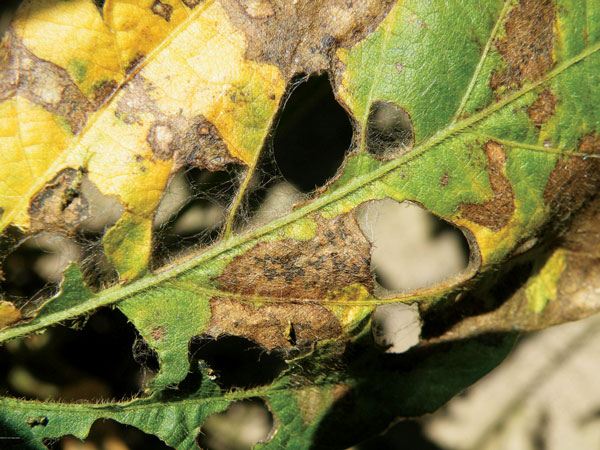December 12, 2014

Aerial web blight can be extremely damaging to soybean plants in reproductive growth stages — it can defoliate plants, as well as remove blooms and young pods.
But a good fungicide program can halt serious aerial web blight and other yield-reducing foliar diseases, says Tom Allen, Mississippi State University Extension plant pathologist.
During the summer of 2014, aerial web blight was observed in fields throughout southern and eastern Mississippi, as well as some other states.
Virtually all soybean varieties are susceptible to the fungus that causes aerial web blight, which can be a tricky foliar disease for some to recognize because it can display different symptoms at different times of the day.
Appearance varies during day
“First thing in the morning, when dew is present on leaf material, leaves can appear to contain water-soaked lesions, and in some cases, leaves will be matted together,” Allen says.
“White fungal growth can also be produced in the early morning hours. The fungal growth can be observed growing between leaves in the lower and middle canopy.”
In the afternoon, Allen notes, once dew is no longer present on leaves, lesions on leaf tissue will appear chestnut brown to maroon in color.
“In most cases, the lesions will appear quite similar to frogeye leaf spot in the afternoon hours. In addition, in some cases, large holes will arise on infected plant material and a brown to maroon ring will appear around the margins of the holes.”
Strobilurin fungicide recommended
Allen advises farmers to select a fungicide product that contains a strobilurin active ingredient to manage aerial web blight.
“The strobilurin chemistry will reduce the spread of the fungus to plant material that has not been previously infected,” he says. “Applications are best made by ground, using equipment that can apply a minimum of 15 gallons of water per acre, using at least 60-plus psi, so the fungicide is blasted through the soybean canopy.
“Aerial applications won’t generally provide good mid- to lower-canopy coverage with the fungicide,” Allen says.
The fungus Rhizoctonia solani causes aerial web blight. “Fungal growth begins at the ground level and moves up the plant,” he says. “However, when slight changes in environmental conditions occur, such as cooler temperatures, the disease will generally shut down and disappear.”
Allen has taken part in numerous fungicide treatment trials. A recent foliar fungicide-efficacy trial conducted in Clay County, Miss., analyzed control of aerial web blight in a continuous soybean field.
Various fungicides were applied. Six days following an application with Quilt Xcel observable disease symptoms were significantly reduced compared to the non-treated check and treatment with Headline, Allen says.
Ratings conducted 23 days post-application determined that treatment with Gem, Quadris, Quilt Xcel and Stratego YLD significantly reduced observable symptoms of aerial blight compared to the non-treated check.
“However, only treatment with Stratego YLD significantly reduced observable foliar symptoms of disease compared to the other fungicides 23 days post-treatment,” Allen says. “Only application with Quadris resulted in a significant yield difference, compared to the non-treated check.”
Efficacy trial findings
In the efficacy trial, ratings conducted 41 days post-treatment determined that treatment with Gem, Quadris, Quilt Xcel, and Stratego YLD significantly reduced observable disease symptoms, but treatments were not significantly different from one another.
Various other diseases hit regional soybean fields in 2014 and should be on the radar of farmers heading into 2015. They include:
• Frogeye leaf spot, continues to be observed throughout the South, Allen says, especially in varieties susceptible to the disease. In addition, widespread strobilurin-resistance has been reported in the fungus responsible for causing frogeye leaf spot.
“If a fungicide that contains a stand-alone strobilurin is applied to a soybean field, don’t expect the fungicide to prevent additional frogeye leaf spot from occurring,” he says.
Frogeye leaf spot got worse
Mississippi State University fungicide trials conducted during the 2013 season indicated that, “regardless of the fungicide product applied to a susceptible soybean variety, the frogeye leaf spot present in the plots post-treatment observationally got worse.
Frogeye leaf spot-resistant soybean varieties — especially in fields with a history of the disease — are one of the best practices for management.
• Target leaf spot: Symptoms of target spot are generally observed as round, concentric rings on affected leaves in the middle to lower canopy.
“Lesions can also be surrounded with a yellow halo,” Allen says. “In severe cases of target spot, the disease will defoliate portions of the lower canopy. Rarely have fungicide trials in Mississippi yielded results on target spot.”
• Downy mildew: This generally appears when soybean plants reach mid-reproductive growth stages and can be mistaken for more damaging diseases like soybean rust, frogeye leaf spot and Septoria brown spot.
“On the underside of the leaf, white-to cream-colored tufts of fungus are present and can be observed with the naked eye or a low-powered hand lens,” Allen says.
Fungicide applications are not necessary, as downy mildew will not contribute to a yield reduction.
Fungicide phytotoxicity responses on soybean plants can falsely be identified as sudden death syndrome, Allen says. He notes that phytotoxicity normally doesn’t cause yield losses, and will generally be observed across an entire field, rather than in a small area like sudden death syndrome.
For more on disease threats to soybean production in your area, contact your local or regional Extension plant pathologist.
You May Also Like




